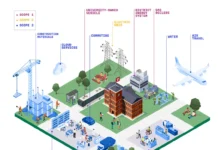If you’ve ever attended a RadTech conference and/or read an issue of UV+EB Technology, you surely know that ultraviolet (UV) and electron beam (EB) are similar technologies that also are very distinctly different. The old adage of apples and oranges applies quite well: UV and EB are both types of radiation polymerization (i.e., types of fruit), and there are instances where the technologies can be interchanged with little effect on the outcome (fruit salad, maybe), but there also are instances where exchanging one technology for another results in noticeable differences or simply fails (caramel oranges on a stick, anyone?).
What causes these differences? Stephen Lapin covered the fundamentals of photons vs. electrons in a previous iteration of this column.1 It’s amazing the impact negativity and a little mass can have on going places! All jokes aside, the decision to change your energy delivery mechanism can affect process requirements. A couple common questions were chosen to explore how and why. The answers provided specifically pertain to free-radical polymerization.
Why doesn’t EB require an initiator?
Ionizing radiation. The accelerated electrons produced by EB have enough energy to ionize molecules, resulting in broken chemical bonds and the free radicals needed to initiate polymerization. UV is largely non-ionizing radiation, and therefore, in most instances, requires a photoinitiator – a molecule specifically designed to break on exposure to the lower energies of UV and provide free radicals.2 Lapin addressed this difference in his article, but it is worth reiterating as it is one of the most influential differences between the two technologies. The need for a photoinitiator has far-reaching implications on factors such as cost, supply chain security, sustainability, migration and weathering/aging, as well as on the answers for the following questions.
Why does EB polymerization require nitrogen inerting?
Oxygen inhibition. Regardless of the initiation mechanism, free-radical polymerization is susceptible to oxygen molecules reacting with the propagating radicals, causing incomplete polymer conversion at the surface.3 Low conversion leads to a tacky, sometimes even wet, surface. In EB, oxygen inhibition is overcome simply by getting rid of as much oxygen in the reaction zone as possible. Air is replaced with ultra-pure (99.999%) nitrogen with a goal of achieving ≤200 ppm O2 on average (with some coatings/inks being more or less sensitive to oxygen). Fun fact: EB lamination doesn’t require inerting because the laminating adhesive is not exposed to air when polymerized!
While some applications of UV polymerization require an inert atmosphere like EB, most often the challenge of oxygen inhibition is mitigated through other means, including photoinitiators. Increasing the concentration of photoinitiator in an ink/coating can increase surface conversion, even in the presence of oxygen.3,4 More photoinitiator (with adequate effective irradiance) means more free radicals – some for sacrificing to the oxygen and the rest to polymerize the coating.
The selection of a photoinitiator that absorbs readily in the UVC also encourages surface cure. In addition, UV always has the greatest amount of energy deposited on the sample surface (Beer-Lambert Law), creating the greatest number of radicals exactly where oxygen can most easily diffuse.5 Because of the difference in the way photons and electrons deposit their energy, this is not true for EB.
Does EB polymerization result in a more cross-linked network than UV polymerization?
Often, yes. Why? Ionizing radiation. Now, of course, there are exceptions to any broad statement, but typically the ionizing radiation of EB results in a variety of different free radicals that can participate in reactions beyond polymerization, including cross-linking.6 Where EB initiation is chaotic, UV initiation is controlled as the radicals are produced from the photoinitiator breaking in a predictable fashion. In the absence of chain transfer, a monofunctional, UV-initiated system only will form linear or branched polymer chains, not a cross-linked network.3
The same formulation initiated with EB likely will form some amount of cross-links as the ionizing radiation breaks liable bonds throughout the formulation, including on newly formed, propagating polymer chains, which create sites for cross-linking to occur. Because of this phenomenon, it is fairly common for inks and coatings originally formulated for UV to have a higher cross-link density when cured with EB, sometimes to the point of becoming brittle and losing adhesion to the substrate. One of the reasons EB is a common choice for use in migration-sensitive applications is that, in addition to the absence of photoinitiator, the cross-linked networks formed make the coating or ink less susceptible to migration.7
 Sage Schissel, Ph.D.
Sage Schissel, Ph.D.
Applications Specialist
PCT Ebeam and Integration LLC
sage.schissel@pctebi.com
References
- Lapin, S., 2015. Question: What are the Fundamental Differences Between UV and EB Technology? UV+EB Technology. https://uvebtech.com/articles/2015/curing-technology/.
- Fouassier, J., Lavee, J., 2012. Photoinitiators for polymer synthesis.
- Odian, G., 2004. Principles of Polymerization. 4th Ed.
- Thiher, N.L.K., Schissel, S.M., Jessop, J.L.P., 2020. Quantifying UV/EB dual cure for successful mitigation of oxygen inhibition and light attenuation. Prog. Org. Coat. (138) 105378.
- Mehnert, R., Pincus, A., Janorksy, I., Stowe, R., Berejka, A., 1998. UV & EB Curing Technology & Equipment. Vol. 1.
- Thiher, N.L.K., Schissel, S.M., Jessop, J.L.P., 2020. The influence of monomer chemistry on radical formation and secondary reactions during electron-beam polymerization. J. Polym. Sci. 58 (7) 1011-1021.
- Chapiro, A., 2004. Radiation Effects in Polymers in Encyclopedia of Materials: Science and Technology. 2nd Ed.





